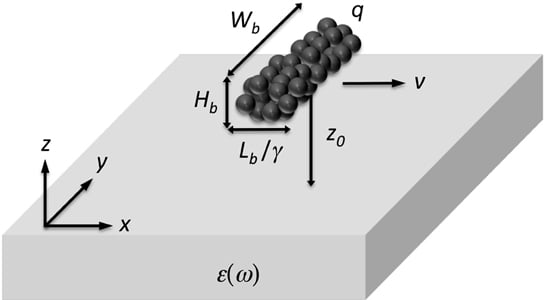
Whereas a point charge is always attracted to an underlying surface, a sideways moving line of charge can be repelled, one physicist calculates. Credit: Primož R. Ribič, Phys. Rev. Lett. (2012)
A newly published study suggests that the interaction between a surface and a charge packet moving parallel to it can become repulsive above a critical relativistic energy. These findings could potentially impact fundamental electrodynamics, accelerator physics, and electron spectroscopy.
An electric charge near the surface of a material gets pulled toward the surface. If the charge is spread out into the right shape and moves fast enough, that attraction becomes a repulsion. This odd finding could help physicists avoid unexpected results when guiding beams of particles like electrons.
The scientists published their findings in the journal Physical Review Letters. Primož Rebernik Ribič, a physicist at the Swiss Federal Institute of Technology in Lausanne, initially thought he was completely wrong, and not everyone agrees with these findings.
Suppose a “point charge,” such as a single electron, is hovering above a surface of a conductor. The electric field generated from the charge pulls and pushes other free-moving charges on the surface. These charges rearrange themselves in a way that causes the point charge and the surface to attract each other. The force equals the one that would be created by an opposite charge, lurking as far below the surface as the original charge hovers above it.
Things get more complicated in an insulator. The positive and negative charge can only shift their positions a bit to polarize the material, but the point charge still induces a pattern of polarization that attracts it to the surface.
If the charge is replaced with a rodlike line of charges that moves sideways, the force from the surface can become repulsive, states Ribič. A point charge moving across the surface of an insulator moves the polarization pattern with it, becoming evanescent waves that still attract the point charge. If the charge moves fast enough, another factor becomes apparent. In an insulating material like glass, light travels slower than in empty space. If a charge moves through the glass faster than light can, it creates a shockwave of light, known as Cherenkov radiation, akin to the sonic boom from a supersonic jet. If a point charge above the insulator moves along faster than light can within the material, the induced polarization pattern will move that fast as well, and creates Cherenkov radiation.
This radiation flows at an angle down to the material, and carries with it momentum. By Newton’s law, the downward flow of momentum must be balanced by an upward push on the point charge. The pull of the evanescent waves always swamps the push of the Cherenkov radiation. When a line of charges moves across the surface, the evanescent waves created by the different points along the line interfere with one another in a way that cancels out the attraction from them. The repulsion from the Cherenkov radiation remains, leaving an overall upward push toward the line of charge. The same holds true for a conductor, states Ribič.
Other physicists state that their calculations indicate that the net force remains attractive for a line of charge, while Georg Hoffstaetter, an accelerator physicist at Cornell University, states that Ribič’s argument is plausible.
Reference: “Can a Metal Surface Repel Electric Charges?” by Primož Rebernik Ribič, 10 December 2012, Physical Review Letters.
DOI: 10.1103/PhysRevLett.109.244801









Be the first to comment on "Cherenkov Radiation Effect in a Line of Point Charges"